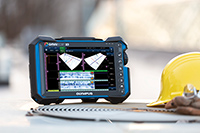Phased array flaw detector
23/04/2020
 OmniScan instruments are recognised globally as the benchmark for portable phased array ultrasonic testing (PAUT) due to their power, reliability and ease of use. The new OmniScan X3 flaw detector elevates the standard with innovations that improve the entire inspection workflow. Setting up for a job is faster and more efficient, while total focusing method (TFM) images collected through full matrix capture (FMC) give users more confidence in their decision-making. When an inspection is complete, leading-edge software tools make analysis and reporting easier.
OmniScan instruments are recognised globally as the benchmark for portable phased array ultrasonic testing (PAUT) due to their power, reliability and ease of use. The new OmniScan X3 flaw detector elevates the standard with innovations that improve the entire inspection workflow. Setting up for a job is faster and more efficient, while total focusing method (TFM) images collected through full matrix capture (FMC) give users more confidence in their decision-making. When an inspection is complete, leading-edge software tools make analysis and reporting easier.The OmniScan X3 flaw detector combines the essential tools needed for PAUT inspections, such as time-of-flight diffraction (TOFD), two ultrasonic testing (UT) channels, eight groups and 16:64PR, 16:128PR and 32:128PR configurations (the 16:64PR configuration limits the number of groups to one TOFD, two PA and two TFM), with powerful innovations, including: TFM/FMC with 64-element aperture support; improved phased array imaging, including an innovative live TFM envelope feature; an acoustic influence map (AIM) simulator for TFM mode; 25 GB file size; up to 1024 × 1024 pixel TFM reconstruction and four simultaneous live TFM propagation modes; a simplified user interface with on-board scan plan; and wireless connectivity to the Olympus Scientific Cloud (OSC), making it simple to keep the instrument’s software up to date.
The comprehensive on-board scan plan tool enables users to visualise the inspection, helping to reduce the risk of errors. The entire scan plan, including the TFM zone, can be created in one simple workflow. Creating a set-up is also faster, with improved calibration tools and support for simultaneous probe and beam set configuration, on-board dual linear, matrix and dual matrix array creation and automatic wedge verification.
Certified IP65 dust proof and water resistant, the instrument has the reliability and ease of use that OmniScan flaw detectors are known for combined with high-quality images that help to make interpreting flaws easier. With TFM, users can produce geometrically correct images to confirm the characterisation of flaws identified through conventional phased array techniques and obtain better images throughout the volume of a part. Additional features that enable outstanding images include a 16-bit A-scan, interpolation and smoothing and a vivid 10.6" WXGA display that provides clarity and visibility in any light.
The OmniScan X3 flaw detector makes analysis and reporting faster, both onboard the instrument and on a PC. The instrument also comes with a variety of helpful data interpretation tools, including circumferential outside diameter (COD) TFM image reconstruction to facilitate interpretation and sizing of long seam weld indications and merged B-scans to facilitate the screening of phased array weld indications while keeping the workflow simple.
Whether inspecting pipes, welds, pressure vessels or composites, the OmniScan X3 flaw detector enables users to complete their work efficiently and interpret flaws with confidence.
www.olympus-ims.com